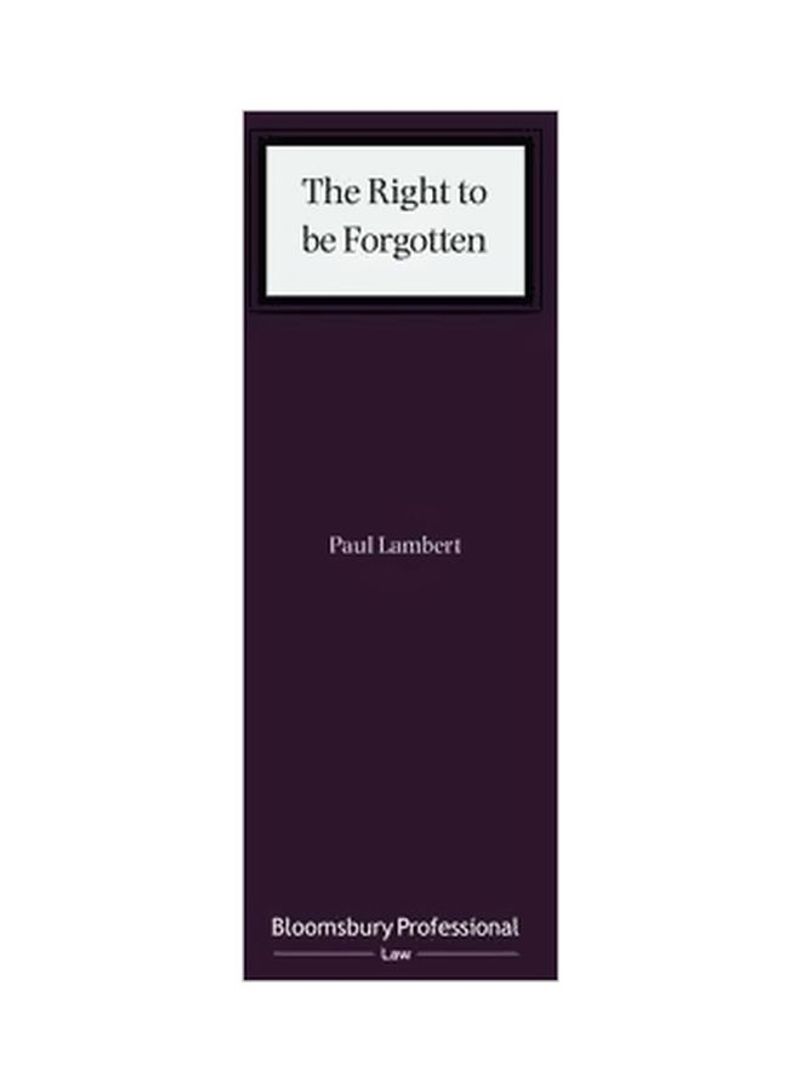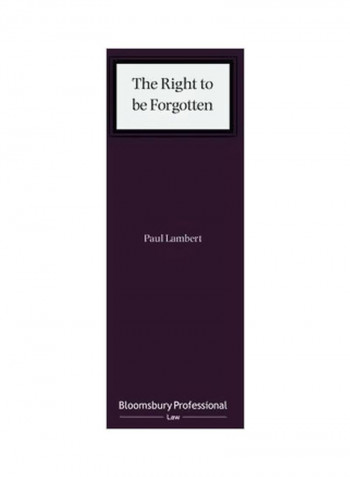The Right To Be Forgotten Hardcover
Recommend
Sort by
Rating
Date
Specifications
Grade
New
Author 1
Paul Lambert
Book Description
The Right to be Forgotten is one of the most publicised areas of the GDPR and has received massive worldwide publicity following judicial and legal developments in Europe. The book covers the Right to be Forgotten, Erasure and Forgetting, Data Protection, GDPR, the Data Protection Act 2018 and Brexit. The Google Spain case received worldwide media attention and legal interest, and cases and disputes on the Right to be Forgotten are increasing. Brexit issues in relation to data protection and the Right to be Forgotten are considered in this new title as a relevant component that may affect some of the contours of this new and expanding legal right.
ISBN-13
9781526510105
Language
English
Publisher
Bloomsbury Publishing PLC
Publication Date
06-Jun-19
Number of Pages
544
About the Author
Dr Paul Lambert, BA LLB LLM, TMA, CTMA, Adjunct Lecturer, Qualified Solicitor, CTMA, PhD, Consultant, has been publishing articles in legal and business journals on topics such as data protection, social media, defamation, internet legal issues, intellectual property and courtroom broadcasting for many years, including the European Intellectual Property Review. He has published books in the US and Europe and spoken and written, and been interviewed, on these issues in the US, Europe and Asia. Writes Data Protection, Information Technology Law, Intellectual Property Law, Media and Social Media Law, Courtroom Broadcasting. Author of Courting Publicity: Twitter and Television Cameras in Court, A User's Guide to Data Protection (third edition), International Handbook of Social Media Laws, Gringras: The Laws of the Internet (fifth edition)
Editorial Review
This is an essential text on an important, new area of law. * The Law Society Gazette * An excellent deep dive into the Right to be Forgotten. I would recommend anyone working in privacy, especially within a technology environment, to read this. -- Stuart Anderson, Managing Director, XpertDPO With this book, Paul Lambert achieved one of the very first, truly profound and up-to-date analyses to the Right to be Forgotten, dedicated not merely to the scope of Article 17 of the GDPR, but also to the path to its evolution, including the widely known 'Google Spain' decision of the European Court of Justice (often seen as a 'Big Bang'), and national law developments, especially in the UK. Since digital memory never forgets and information merging progresses in somewhat alarming ways, manifesting itself in today's threats - blackmailing, stalking, revenge porn, deep fakes, to name but a few - the author points out the strengths and weaknesses of this legal concept. This clearly structured book is therefore highly recommended to all those who would like to develop a deeper understanding of the necessities and different views going beyond Article 17 of the GDPR to approach the significance of a 'digital amnesia' which should by no means be underestimated. -- Christopher Schmidt, Magister of Law Data Privacy Specialist, certified CIPP/E, CIPM, CIPT, CBSA Dr. Paul Lambert's book succeeds in offering an astonishing and prescient examination of the privacy implications and consideration of the right to be forgotten in the digital age. The internet and technologies using personal data are built to remember and never forget, so the right to be forgotten not only explores ethical and legal questions but technical challenges as well. Dr. Lambert leaves no stone unturned in his examination of the right to be forgotten and offers a wide range of information about its ripple effects on privacy in the digital world as we know it. -- Debbie Reynolds, EimerStahl With "Right to be Forgotten - Interpretation and Practice Textbook", Paul Lambert goes well beyond the legal analysis of the right to be forgotten that can be found in the current literature. For the first time the reader gets a comprehensive approach to the problem of data processing and management across long periods of time and how it connects with the will of data subjects that such processing and disclosure be erased and thus forgotten. Dr. Lambert addresses the legal problem starting from a societal approach of great importance reflected on chapters one to three. This is key to understanding how the need to be forgotten came to be an important legal issue of our time and how it influenced the law. The author then proceeds to analyze the legal framework and regime for the right to be forgotten with great detail and special attention to its caselaw origins at the CJEU but without forgetting national case law and the guidance of the Article 29 Working Party. This is done with clear language and practical examples to illustrate analysis. Paul Lambert's "Right to be Forgotten - Interpretation and Practice Textbook" immediately ranks as fundamental work regarding this new and important right and constitutes an important tool for any operator in the privacy and data protection ecosystem. -- Domingos Soares Farinho Professor, University of Lisbon School of Law Privacy and Data Protection Lawyer The internet allows our misdemeanours and mistakes to come back to haunt us. Digital footprints are visible long after the storm has past and human interest has waned. The right to be forgotten balances this out by enabling some people to wipe the digital slate clean. The right is still in its infancy and finding its feet however and Paul Lambert's book provides what every data protection lawyers really need right now, that is a clear and simple exposition of how the right can be contextualised and put within the broader data protection framework. -- Professor Phillip Johnson, Cardiff University My initial reaction to a 500+ page textbook only about The Right to be Forgotten was to wonder what on earth there was to talk about. However, having reviewed Paul Lambert's text and seen what a thorough account he has provided on the subject, this makes more sense. As well as tracking the history of the original Google Spain Case (a case in which Bristows was heavily involved), Lambert also considers the development of the modern commercial internet, including social media in particular, and the growing need for individuals to be able to manage their online presence in certain situations. The advent of 'revenge porn' is a good example of this, which the book covers in a reasonable amount of detail. The impact of GDPR is also looked at closely, as well as the way in which it has developed and modified the RtbF as originally seen in the Google Spain case. Moreover, various national cases that have looked at the RtbF are described and analysed, with the UK's NT 1 and NT2, deserving of a chapter each. The impact of RtbF on the media - a highly contentious area - is also looked, as is the potential impact of Brexit. Overall, this is a solid piece of work that will provide a useful resource for anyone involved in weighing the respective rights of privacy and data protection and freedom of expression and other, competing rights. -- Mark Watts * Bristows Law Firm *



